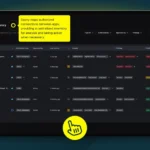In cybersecurity, particularly within the identity security space, the term “toxic combinations” frequently emerges as a key point of concern. But what exactly does this term mean? Generally speaking, toxic combinations are defined as a combination of access rights that provide users with rights beyond what is needed to complete their job, posing a threat to organizational security or compliance. However, this term takes on a more expanded definition when applied to the increasingly utilized Software as a Service (SaaS) applications upon which many of today’s organizations rely.
This article delves into the depths of toxic combinations in SaaS environments, illustrating their potential to compound seemingly minor vulnerabilities into substantial security threats. As SaaS apps become integral to our everyday business operations, understanding and addressing these toxic combinations is not just advisable; it’s imperative to safeguard the integrity of our data and our organizational resources. Let’s explore the intricate dynamics of toxic combinations within SaaS apps and why it’s become crucial to address them.
What is Meant by Toxic Combinations?
Toxic combinations occur when multiple minor vulnerabilities converge within a single identity in SaaS apps. These vulnerabilities might seem minor individually, but when they accumulate within one identity, they exponentially increase the risk of a security breach.
Examples of Toxic Combinations
A classic example of this is when an employee has multiple accounts for a SaaS service, with one being an administrator. Using the administrator account, they can do things that are outside their normal permissions.
In SaaS environments, toxic combinations often involve scenarios such as an employee using the same weak password across multiple critical applications, combined with the absence of multi-factor authentication (MFA). This significantly increases the risk of unauthorized access.
Another typical example is when an employee retains outdated access permissions unrelated to their current role. If coupled with insufficient activity monitoring, this could allow unnoticed unauthorized access to sensitive data.
An equally common example might be an identity that exhibits risky behaviors like logging in from unsecured networks or downloading unauthorized applications. Combined with that identity having high-level access privileges, there is a vast potential for data breaches and system compromises.
These are all examples of how combinations of minor vulnerabilities can compound to create significant security risks.
The Importance of Addressing Toxic Combinations
Why are Toxic Combinations a Problem?
Toxic combinations amplify the potential for breaches in ways that are not always apparent through traditional security assessments. The primary issue is the multiplicative effect of risk factors—where the whole becomes greater than the sum of its parts. This complexity often makes toxic combinations difficult to detect, as security systems typically look for single, clear-cut indicators of compromise. However, when multiple low-risk indicators are combined, they can slip under the radar until they culminate in a significant breach.
Why Does it Matter for SaaS Applications?
SaaS platforms are particularly susceptible to the risks posed by toxic combinations due to their widespread accessibility and the centrality of the data they manage. Most SaaS apps are accessible from anywhere, at any time, making them attractive targets for cyber-attacks. Additionally, they often store and process sensitive business and personal data, which can include everything from financial records to personal health information. The centralized nature of SaaS apps means that compromising one part of the system can potentially give attackers access to a vast trove of critical data. Therefore, ensuring that each identity accessing these platforms is secure is crucial, emphasizing the need to address and mitigate toxic combinations effectively.
Identifying and Understanding Toxic Combinations
Savvy’s platform provides comprehensive visibility into all SaaS usage, highlighting vulnerabilities and risky combinations of access rights and user behaviors. This visibility is crucial in detecting potential toxic combinations early, before they lead to breaches.
Best Practices and Preventative Measures
Organizations can mitigate the risk of toxic combinations by adopting several best practices:
- Stringent Access Controls: Enforce strict access controls and regularly review who has access to what data and why, ensuring that access is granted based on the principle of least privilege.
- Regular Security Training: Conduct regular training sessions for employees to emphasize the importance of good security practices such as using strong, unique passwords and recognizing phishing attempts.
- Routine Security Audits: Regularly perform security audits to check for vulnerabilities in the system and assess the effectiveness of current security measures.
Savvy’s Role in Managing Toxic Combinations
Savvy addresses toxic combinations by providing a suite of powerful features designed to enhance identity security in SaaS environments:
- Automated Remediation: Through its automation capabilities, Savvy can instantly remediate identified risks by adjusting access controls, enforcing password resets, or triggering multi-factor authentication requirements where necessary.
- Flexible Policy Controls: Savvy allows organizations to configure security policies that are both adaptive and specific to their operational needs, enabling them to dynamically adjust security measures based on the risk level of identity behaviors.
How does Savvy integrate with existing security infrastructure?
Savvy is designed to seamlessly integrate with existing security infrastructures, enhancing its utility without requiring significant changes to current systems. Savvy can connect with various identity providers and security tools, pulling data from these sources to provide a comprehensive view of identity risks. Its integration capabilities allow it to enhance existing security measures by providing deeper insights and automated response options, which help effectively manage and mitigate risks associated with toxic combinations in SaaS environments.
Conclusion
The increasing complexity and scale of SaaS environments have made traditional security measures insufficient, particularly in managing the myriad of identities and their access across numerous applications. Toxic combinations of minor risks can escalate into severe ones, making it crucial for organizations to adopt advanced, intelligent solutions like Savvy. By providing comprehensive visibility, automated remediation, flexible policy controls, and robust compliance support, Savvy enables organizations to address these combinations effectively and efficiently. Embracing such sophisticated security solutions not only mitigates risks but also enhances operational integrity and compliance, securing the trust of clients and stakeholders in the increasingly interconnected digital world. Savvy ensures that all organizations can maintain a robust security posture, adapt to evolving threats, and continue to thrive in a landscape where identity management is paramount.
Discover how integrating Savvy into your cybersecurity strategy can transform how your business handles identity risks, eliminating potential vulnerabilities without disrupting productivity. To learn more about our proactive approach to security and how it empowers your organizations to leverage the full potential of SaaS apps safely — schedule a demo today.


